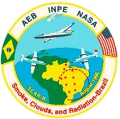Smoke, Clouds, and Radiation - Brazil

Disciplines: Aerosols Radiation Budget Tropospheric Composition Field Campaigns
| Collection | Disciplines | Spatial | Temporal |
|---|---|---|---|
|
SCAR_B_AERONET_1
Sulfates, Clouds and Radiation Brazil (SCAR-B) AERONET (AErosol RObotic NETwork) Data |
Aerosols, Radiation Budget, Field Campaigns |
Spatial Coverage: (S: -20.45, N: -2.43), (W: -62.87, E: -47.9) |
Temporal Coverage: 1995-08-01 - 1995-09-30 |
|
SCAR_B_G8_FIRE_1
Smoke/Sulfates, Clouds and Radiation Experiment in Brazil (SCAR-B) Data Set Version 5.5 |
Aerosols, Radiation Budget, Tropospheric Composition, Field Campaigns |
Spatial Coverage: (S: -40, N: 1), (W: -76, E: -35) |
Temporal Coverage: 1995-06-01 - 1995-10-31 |
| Collection | Disciplines | Spatial | Temporal |
|---|---|---|---|
|
SCARB_ER2_MAS_1
Smoke, Clouds and Radiation Brazil NASA ER-2 Moderate Resolution Imaging Spectrometer (MODIS) Airborne Simulator (MAS) Data |
Aerosols, Radiation Budget, Tropospheric Composition, Field Campaigns |
Spatial Coverage: (S: -44, N: 36), (W: -118, E: -18) |
Temporal Coverage: 1995-08-13 - 1995-09-11 |
| Collection | Disciplines | Spatial | Temporal |
|---|---|---|---|
|
SCAR_B_UWC131A_1
Sulfates, Clouds and Radiation Brazil (SCAR-B) University of Washington C131A Data |
Aerosols, Clouds |
Spatial Coverage: (S: -16.85, N: -2.42), (W: -64.75, E: -47.5) |
Temporal Coverage: 1995-08-17 - 1995-09-20 |
SCAR-B Mission Publications
King MD, Tsay S-C, Ackerman SA, Larsen NF (1998). Discriminating heavy aerosol, clouds, and fires during SCAR-B: Application of airborne multispectral MAS data. Journal of Geophysical Research, 103 (D24), 31989. https://doi.org/10.1029/98JD01043